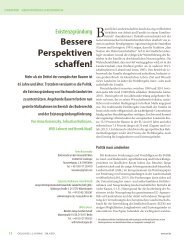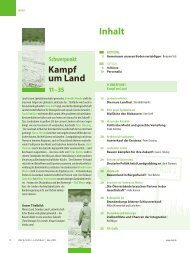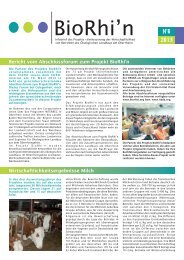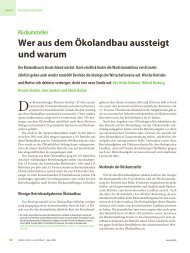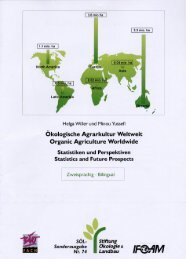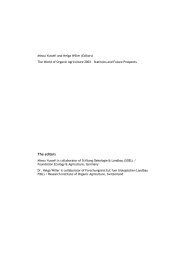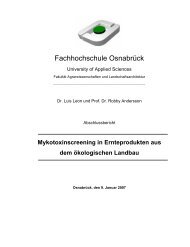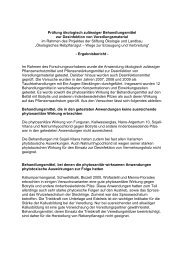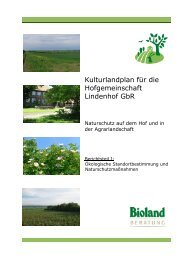the world of organic agriculture - Organic Eprints
the world of organic agriculture - Organic Eprints
the world of organic agriculture - Organic Eprints
Create successful ePaper yourself
Turn your PDF publications into a flip-book with our unique Google optimized e-Paper software.
3 Contacts and Data Sources<br />
In <strong>the</strong> future, following <strong>the</strong> completion <strong>of</strong> <strong>the</strong> free trade zone and <strong>the</strong> expansion <strong>of</strong> <strong>the</strong> local<br />
market, this regulatory gap may become a stumbling block. Many efforts are being undertaken<br />
to improve local markets (El Araby, 2004).<br />
In Israel (Eshel and Rilov, 2004), <strong>the</strong> total <strong>organic</strong> sector is worth 180 million USD 5 , 30 percent<br />
<strong>of</strong> which are marketed locally, whereas <strong>the</strong> remainder is exported. There are 17 authorized<br />
<strong>organic</strong> shops, 50 points <strong>of</strong> sale in supermarkets and also a few hundred health food shops that<br />
sell <strong>organic</strong> products. There are 12 companies dealing with <strong>organic</strong> export. The total volume <strong>of</strong><br />
<strong>organic</strong> export is around 35 million USD 6 per year (2003) <strong>of</strong> fresh products. The local market<br />
covers around 10 million USD 7 .<br />
In Lebanon (Khoury, 2004), export is being done by BioCoop and by local businessmen mainly<br />
to <strong>the</strong> Gulf area. The value <strong>of</strong> <strong>the</strong> Lebanese production <strong>of</strong> fresh <strong>organic</strong> produce (vegetables and<br />
fruits) for <strong>the</strong> year 2003 is estimated around 875’000 USD 8 .There are 23 between Health shops,<br />
hypermarkets and restaurants. No data are available yet on <strong>organic</strong> produce in terms <strong>of</strong> quantity<br />
or value on Import/Export.<br />
In Malta (Calleja, 2004), about half <strong>of</strong> <strong>the</strong> <strong>organic</strong> producers sell <strong>the</strong>ir products at <strong>the</strong> farmers’<br />
market. The o<strong>the</strong>r half sell <strong>the</strong>m door to door or directly to a store or shop. Exportation is as yet<br />
non-existent. Data on domestic consumption is still not available, both for local and imported<br />
<strong>organic</strong> products. Imported <strong>organic</strong> products are available at supermarkets. The main countries<br />
<strong>of</strong> import are Italy, <strong>the</strong> UK and Germany.<br />
In <strong>the</strong> absence <strong>of</strong> local market and national labeling systems, <strong>organic</strong> food produced in Morocco<br />
is oriented primarily towards exports (Kenny, 2004). Vegetables (especially tomatoes and<br />
cucumbers) and citrus account for 95 percent <strong>of</strong> <strong>the</strong> goods that are exported to France, <strong>the</strong> UK<br />
and Germany. For fruits and vegetables, 20 to 30 percent <strong>of</strong> <strong>the</strong> national production is excluded<br />
from export and is sold in local markets as conventional products. There is, however, an exception<br />
for this regarding argan oil 9 , which is sold as <strong>organic</strong> even in local markets. Fruits, vegetables and<br />
o<strong>the</strong>r horticultural commodities are exported exclusively to <strong>the</strong> European markets while essential<br />
and argan oils are exported to Europe and nor<strong>the</strong>rn American markets (Canada and USA).<br />
In Tunisia (Ben Kheder, 2004), most <strong>of</strong> <strong>the</strong> production is directed to <strong>the</strong> export market and sold<br />
as typical Tunisian products. The main products are: olive oil and dates. The production <strong>of</strong> o<strong>the</strong>r<br />
crops is still low and is marketed mainly in <strong>the</strong> local market, but no real local market for <strong>organic</strong><br />
products does exist as yet. A strategy is being prepared to encourage local consumption and<br />
marketing <strong>of</strong> <strong>organic</strong> products. Recently, some companies started to export <strong>organic</strong> products.<br />
5 180 million USD = 148.1 million EUR (per 31.12.2005)<br />
6 35 million USD = 28.8 million EUR (per 31.12.2005)<br />
7 10 million USD = 8.2 million EUR (per 31.12.2005)<br />
8 875’000 USD = 739’051 5 EUR (per 31.12.2005)<br />
9 Argan oil comes from <strong>the</strong> nuts <strong>of</strong> <strong>the</strong> Argan tree (Argania spinosa).This tree grows only in <strong>the</strong> South Western part <strong>of</strong><br />
Morocco in an area covering 700’000-800’000 hectares (Source: http://www.dietobio.com/aliments/en/argan.html)<br />
179



